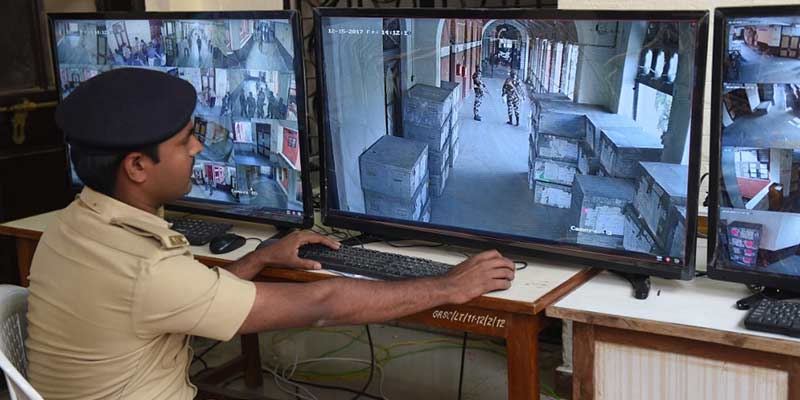- India
- Jul 10
Can facial recognition help fight crime?
The National Crime Records Bureau (NCRB) has pitched for the creation of an Automated Facial Recognition System (AFRS) and has initiated a proposal for its implementation.
The NCRB has already undertaken an initiative to roll out the National Automated Fingerprint Identification System (NAFIS) and its subsequent integration with the Crime and Criminal Tracking Network System (CCTNS) application. Further, the need for a facial recognition system is being felt by police personnel on the field to enhance the penetration and usage of available image data.
The AFRS will be a centralised web application hosted at the NCRB data centre in New Delhi, which will be made available for all police stations across the country.
What is facial recognition?
A facial recognition system is a technology capable of identifying or verifying a person from a digital image or video source. They work by comparing selected facial features from a given image with faces available in a database.
This system is a great investigation enhancer for the identification of criminals, missing children / persons, unidentified dead bodies and unknown traced children / persons.
The Automated Facial Recognition System (AFRS) would help in the automatic identification and verification of persons.
The proposed system will be made available through a mobile app for police personnel.
What are its advantages?
The AFRS is part of an effort to modernise the police force, information gathering, criminal identification, verification and its dissemination among various police forces.
The system can play a vital role in improving outcomes in criminal identification and verification by facilitating easy recording, analysis, retrieval and sharing of information between different organisations.
The availability of quick and timely information can bring a sea change in the act of tackling crime and criminals.
The creation and maintenance of a database of photographs in digital form is essential in order to effectively meet the challenges of criminal identification and verification.
Telangana model
Telangana was the first state to implement a facial recognition system in a bid to prevent and detect crimes in real time. The system was launched in August 2018 as an integrated feature of the TSCOP mobile app.
The Delhi Police started using a facial recognition system on a trial basis last year.
In an affidavit to the Delhi High Court, the Ministry of Women and Child Development said that the Delhi Police had used the FRS on 45,000 children living in different children’s homes. The ministry had provided data on seven lakh missing children along with their photographs. Of them, the police were able to identify 2,930 children with the software.
However, the High Court was not impressed noted that the facial recognition software used by the police has not helped in cracking any missing child case, as more than 5,000 children who disappeared from the national capital in the past three years remain untraced.
What are the main concerns?
While the benefits of the technology for law enforcement agencies in fighting crime and identifying missing persons cannot be denied, its misuse can lead to trouble. The main concern is regarding breach of right to privacy.
“Amid National Crime Records Bureau’s controversial step to install an automated facial recognition system, India should take note of the ongoing privacy debate in the US. Indian citizens are more vulnerable in the absence of a data protection law,” former IT Minister Milind Deora tweeted recently with a news clip that the US immigration agency was scanning drivers’ licences with the technology.
Experts say there is no framework to regulate the storage of facial recognition data in India.
Major technology giants such as Microsoft and Amazon also agree that there is a need for governments to regulate this technology.
In a blog post in December 2018, Microsoft president Brad Smith pointed out that certain uses can increase the risk of biased decisions and outcomes, intrusions into people’s privacy and encroach on democratic freedoms if the technology is used for mass surveillance.
Amazon Web Services also supports the creation of a legislative framework covering facial recognition through video and photo monitoring in public or commercial premises.
Fingerprint system
The NCRB is in the process of launching a National Automated Fingerprint Identification System (NAFIS) and its subsequent integration in the Crime and Criminal Tracking Network System (CCTNS).
The CCTNS is envisaged as a nationwide integrated database on crime incidents and criminals. It aims to connect all police stations and their criminal data with a central database for real-time access to information.
Objectives of NAFIS
The proposed NAFIS solution is envisaged to consolidate all fingerprint data available with states/UTs for the creation of a national-level searchable fingerprint database.
The proposed system has configurable virtual partitions with write access only to the respective states/UTs, while the search facility will be available across virtual partitions in a national search.
In the second phase, a fingerprint enrolment device along with a scanner-reader device will be deployed at police stations for accessing the central NAFIS database for quick response.
The proposed system will provide NAFIS database interconnectivity and able to exchange fingerprint data electronically with other standard AFIS system across the world.

